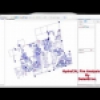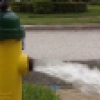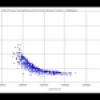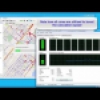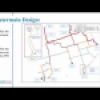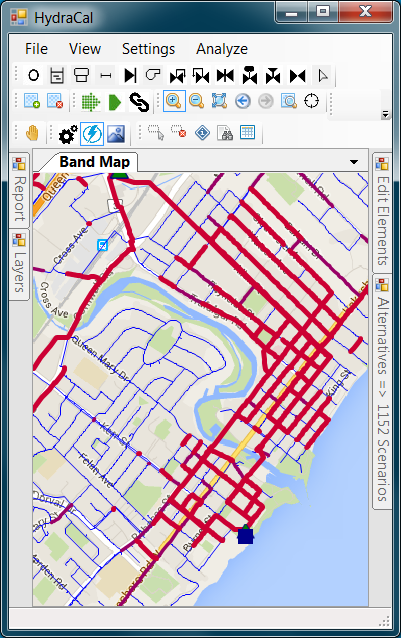HydraCAL
Features and Capabilities
HydraCAL Unique Capabilities
HydraCAL is a framework to simulate water distribution systems. It allow you to build your system from scratch or import and edit your existing model from other software (e.g. InfoWater, WaterGEMS) through industry standard EpaNET INP format.
What makes HydraCAL© unique is its patent pending algorithm to automatically generate all network operational scenarios, simulate them and report the simulation results. Hydraulic engineers and utility managers could use this ability to quickly check and evaluate their plan under the full range system scenarios.
The following is a list of HydraCAL© major futures.
Eliminating Human Mistakes
Regardless of the software used (e.g., EPANET, InfoWater, or WaterGEMS), the traditional approach includes several repetitive tasks such as preparing scenarios manually, simulating them, and finally monitoring the system and reporting the issues. All of these steps are time consuming.
Humans are prone to mistakes, especially for repetitive tasks, so mistakes are inevitable during the design process. HydraCAL automatically generates all of the possible scenarios, simulates them, monitors the simulation outputs, and finally reports the issues only. As a result, it effectively eliminates most human-related errors. Moreover, in case of any mistake or changing the design criteria, the entire process is easily repeatable; comparatively, in the traditional approach, most steps require manual oversight.
 Parallel Processing
Parallel Processing
Today's personal computers have at least 4 to 8 computational cores on their CPU. HydraCAL is deigned to utilize this computational power to its full extent with just a single click, thereby significantly improving computational efficiency. This means that the time required to evaluate the systems is drastically reduced.
True System Evaluation
In the traditional design approach, engineers only evaluate their designs under a limited number of scenarios.
HydraCAL generates and evaluates all of the system operating conditions automatically; thus, it truly evaluate the design under the full range of system conditions.
GIS-Friendly Environment
HydraCAL provides a simple and very powerful GIS framework that satisfies the GIS-related needs of a hydraulic designer without the requirement for extensive GIS expertise. Additionally, because HydraCAL is a standalone application, it does not require additional software such as ArcGIS. As such, there are no extra costs nor extra licensing requirements.
Energy Optimization
Energy represents one of the largest portions of water distribution system operational costs. HydraCAL uses the Pump Energy Index (PEI) to estimate energy consumption for each system scenario. Utility managers can use such metrics and approaches to identify opportunities for energy savings, thereby reducing their energy footprint.
Probabilistic Process vs. Deterministic Approach
Several GB of SCADA data are continuously collected everyday to record system states and performance.
HydraCAL is able to estimate the probability of each design scenario using SCADA data. This means that designers can gain a comprehensive understanding of how each hydraulic variable changes and predict future behaviour via statistical methods. HydraCAL incorporates this into the design process. Thus, with HydraCAL, it is possible to size a watermain based on its most probable flow rather than an assumed flow by designer for instance.
Operational System Bands vs. System Curve
In traditional design approaches, designers use system curves to select and design pumps. A system curve illustrates the relationship between flow and head at a pump station. When using this approach, only the flow at a pump station is considered as to be variable, and all other system boundary conditions (e.g., reservoir water levels, other pump stations) are assumed to remain fixed. This means that the system curve is estimated for a specific system condition.
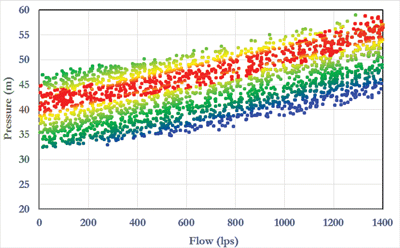
In reality, a water distribution system can operate under thousands scenarios with near infinite combinations of variables. Accordingly, the relationship between head and flow forms a band of curves rather than just a single curve. Reducing this band to a curve eliminates valuable information, and it can lead to selecting a pump with performance issues (e.g., lower efficiency over its operating points). HydraCAL allows you to generate operational system bands, which can be combines with probability analyses to select appropriate pumps.
GET IN TOUCH
- 252 Stone Road West,
Unit 35, Guelph, Ontario, CANADA - Phone: +1 647 447 8830
- Email: info@dataab.com
About
DataAb Inc offers HydraCAL 2015 which helps you with evaluating your designs for water distributions system components such as watermains , pump stations, etc.

